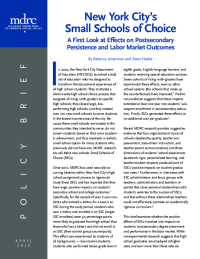New York City’s Small Schools of Choice
A First Look at Effects on Postsecondary Persistence and Labor Market Outcomes

In 2002, the New York City Department of Education (NYCDOE) launched a bold set of education reforms designed to transform the educational experiences of all high school students: They instituted a district-wide high school choice process that assigned all rising ninth-graders to specific high schools; they closed large, low-performing high schools; and they created over 100 new small schools to serve students in the lowest-income areas of the city. Because these small schools are located in the communities they intended to serve, do not screen students based on their prior academic achievement, and thus represent a realistic small school option for many students who previously did not have one, MDRC researchers call these new schools Small Schools of Choice (SSCs).
Since 2010, MDRC has used naturally occurring lotteries within New York City’s high school assignment process to rigorously study these SSCs and has reported that they have large, positive impacts on students’ secondary school and college outcomes. Specifically, for the sample of over 21,000 students who entered a lottery for a seat in an SSC during the study period, students who won a lottery and enrolled in an SSC (target SSC enrollees) were 9.5 percentage points more likely to graduate from high school than those who lost a lottery and did not enroll in an SSC (their control group counterparts). This effect was experienced by students of all backgrounds — low-income students, students who performed below grade level in eighth grade, English-language learners, and students receiving special education services. Seven cohorts of rising ninth-graders have experienced these effects, even as other school options (the schools that make up the counterfactual) have improved. Preliminary evidence suggests that these impacts extended at least one year into students’ subsequent enrollment in postsecondary education. Finally, SSCs generated these effects at no additional cost per graduate.
Recent MDRC research provides suggestive evidence that four organizational inputs of schools (leadership quality, teacher empowerment, data-driven instruction, and teacher-parent communication) and three dimensions of students’ school experiences (academic rigor, personalized learning, and teacher-student respect) produced part of SSCs’ positive impacts on student graduation rates. Furthermore, in interviews with SSC administrators and focus groups with teachers, administrators and teachers reported that close personal relationships with students were key to the success of SSCs, and that without these relationships teachers could not effectively promote an academically rigorous curriculum.
This brief examines whether the positive effects of SSCs translate into impacts on students’ postsecondary degree attainment and performance in the labor market. Findings in this policy brief bring together a uniquely diverse set of data — NYCDOE high school enrollment and graduation data, National Student Clearinghouse data, and New York State (NYS) unemployment insurance data — to provide an early look at the SSC sample’s experiences in college and work after high school, a pivotal transitional period in an adolescent’s life.
An earlier MDRC report on SSCs found that their impact on high school graduation translated into a similar size impact on enrollment in postsecondary school after high school graduation. This brief presents findings from a study of SSCs’ impact on postsecondary education and labor market outcomes that follows four cohorts for four years after high school graduation and one of these cohorts for six years after graduation. In addition, for a subset of students in these four cohorts, it gives a first look at whether SSCs had an effect on students’ employment prospects or outcomes four years after graduating from high school, and how much income they earned.
The study found the following:
-
Through the follow-up period, the original effect that SSCs had on enrollment in postsecondary education decreased but persisted: After four years, SSC enrollees were 4.6 percentage points more likely to be enrolled in postsecondary education than their control group counterparts. Students of all backgrounds experienced this positive effect. For the one cohort of students that the research team was able to follow for six years, there was a small, positive, but not statistically significant, effect on postsecondary degree attainment; the sample was small and further follow-up is needed.
-
Even though they were enrolled in postsecondary education at a greater rate, SSC enrollees were as likely as their control group counterparts to have been employed. For the subsample of students for whom both postsecondary enrollment and labor market data were available, there was no difference between the employment rates and annual earnings of SSC enrollees and those of control group students.
- However, when both postsecondary enrollment and employment are considered together or jointly, SSC enrollment had a positive effect of 4.8 percentage points on the number of students participating in a “productive activity” (enrolled in postsecondary education, employed, or both).






